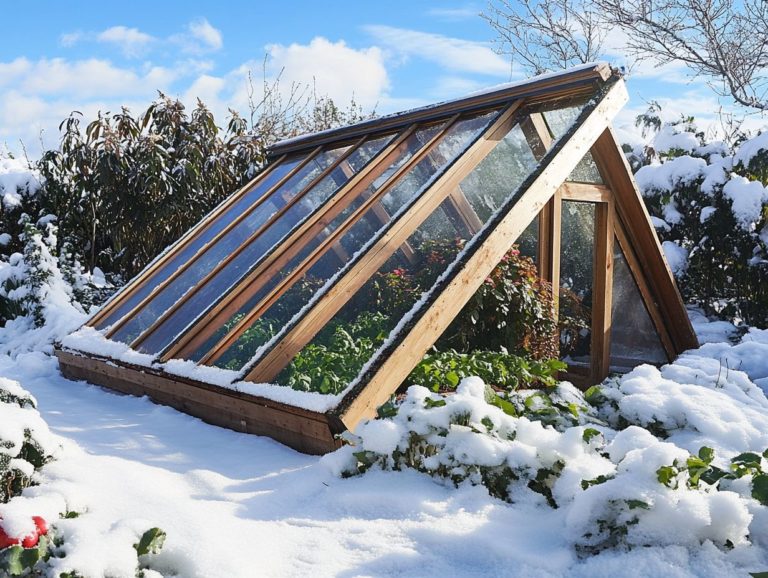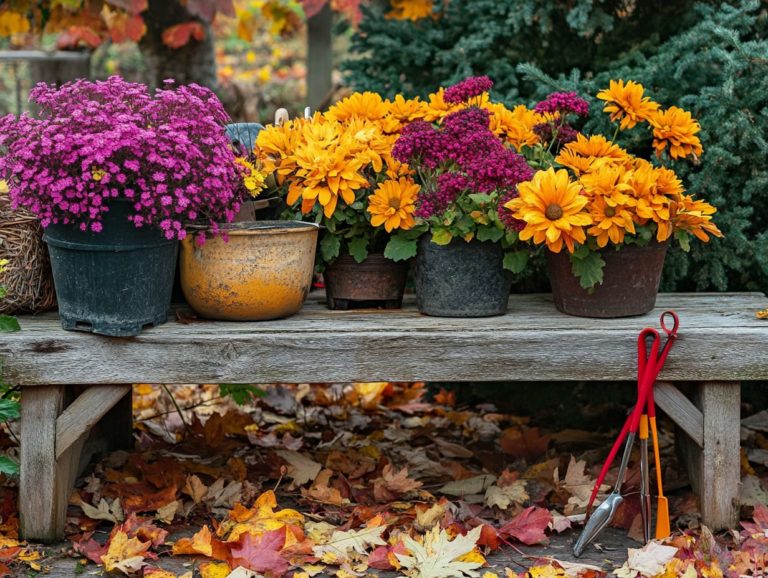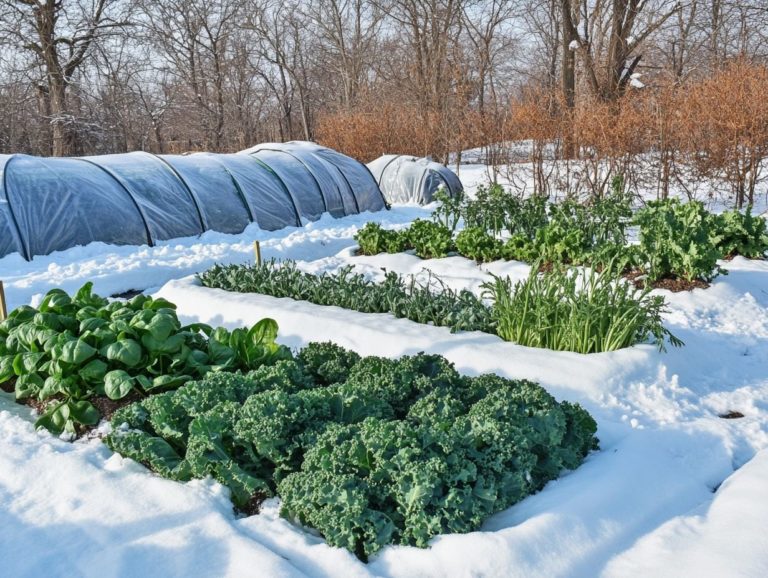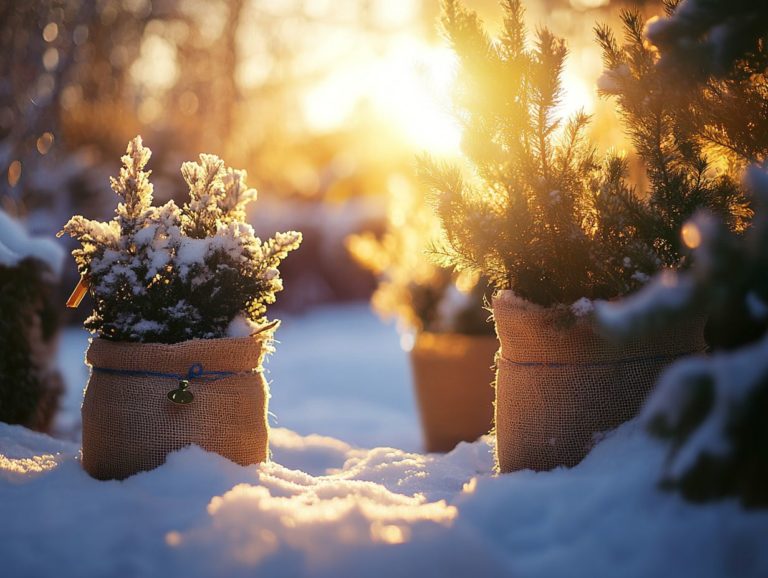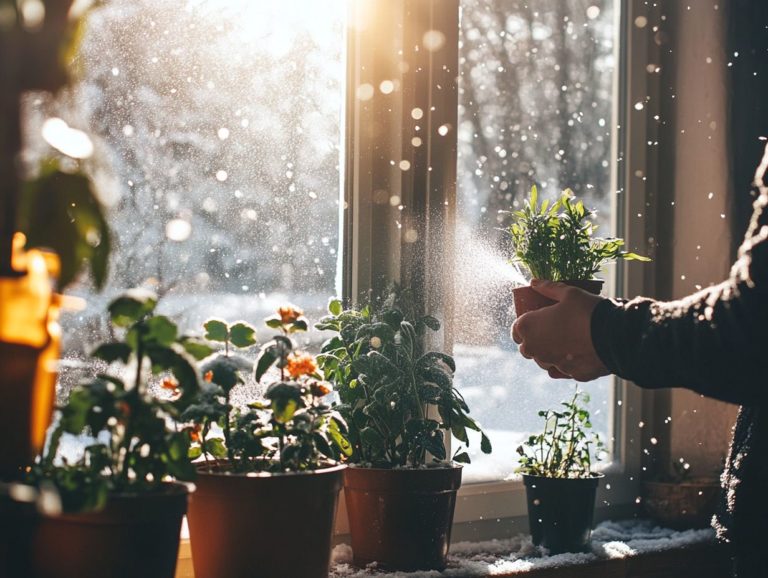How to Identify Cold-Climate Gardening Challenges
Gardening in cold climates presents exciting challenges for gardeners. Shorter growing seasons, unpredictable frosts, and the heavy weight of snow can leave even the most experienced gardeners feeling overwhelmed.
It s crucial to understand what defines a cold climate and how to navigate its hurdles skillfully. This guide delves into the common obstacles you might encounter as a cold-climate gardener and offers practical strategies to help you succeed everything from selecting hardy plants to optimizing soil and sunlight.
Whether you re just starting out or looking to polish your skills, this guide will empower you to cultivate a thriving garden, no matter how chilly it gets.
Contents
- Key Takeaways:
- Understanding Cold-Climate Gardening
- Common Challenges in Cold-Climate Gardening
- Strategies for Dealing with Cold-Climate Challenges
- Tips for Successful Cold-Climate Gardening
- Frequently Asked Questions
- What are some common challenges when gardening in a cold-climate?
- How can I identify if my garden is in a cold-climate region?
- What types of plants are best suited for cold-climate gardening?
- What are some signs of frost damage to plants?
- How can I protect my garden from cold-climate challenges?
- What are some resources to help me identify and overcome cold-climate gardening challenges?
Key Takeaways:

- Prepare for a shorter growing season, frost and freezing temperatures, and heavy snow and ice.
- Choose cold-resistant plants and protect them from frost.
- Maximize sunlight and ensure proper soil preparation for success.
Understanding Cold-Climate Gardening
Cold-climate gardening is the art of growing plants where winter is harsh and growing conditions are less than ideal. If you find yourself in areas like Utah, where the dates when frost is likely to occur dictate your gardening endeavors, mastering the key principles of cold-climate gardening is key to cultivating a thriving vegetable garden.
Embracing organic gardening practices and selecting hardy vegetables and perennials that can withstand the chill will serve you well. By honing techniques like meticulous soil preparation and implementing strategic planting schedules, you can significantly increase your chances of a fruitful harvest, even in the face of a demanding cold season.
What is Considered a Cold Climate?
A cold climate is characterized by its distinctive conditions, including numerous frost days, a brief growing season, and temperatures often dipping below freezing. This environment significantly affects plant growth and survival. Understanding the specific first and last frost dates in your area is vital for optimizing your planting schedules and managing your vegetable garden effectively.
In these regions, temperatures typically hover between 32 F (0 C) and 50 F (10 C) during key months. You must plan accordingly. The existence of microclimates localized areas with slightly different temperature and moisture levels can provide unexpected advantages. These variations can create pockets of warmth, enabling you to cultivate hardy varieties that might struggle in the surrounding chill.
By recognizing these nuances, you can refine your gardening techniques, choosing the right crops and employing protective measures like row covers or cold frames. This proactive approach allows you to thrive even as frost looms over much of the landscape.
Common Challenges in Cold-Climate Gardening
Gardening in cold climates presents exciting challenges that can test even the most seasoned gardening enthusiasts. You’ll navigate a short growing season that limits your crop selection while facing the ever-present threat of frost and freezing temperatures that could jeopardize tender plants. For tips on overcoming winter gardening challenges, it’s essential to prepare for heavy snow and ice, which complicate your outdoor gardening efforts.
These conditions require careful planning and innovative strategies to secure successful harvests despite the environmental constraints.
Short Growing Season
A short growing season presents challenges for you as a gardener, especially in cold-climate regions, where the window for planting and harvesting is significantly narrowed. Choose crops wisely to maximize your harvest!
Understand your local climate and soil for better crop choices. Fast-maturing plants like radishes, lettuce, and certain beans not only yield quick returns but also allow for successive planting, making the most of your limited growing period.
Using techniques like row covers protective sheets that trap heat and cold frames mini greenhouses can further extend your valuable growing window. Your strategic selection and management of these fast-growing options can significantly enhance food security and sustainability in colder regions.
Frost and Freezing Temperatures
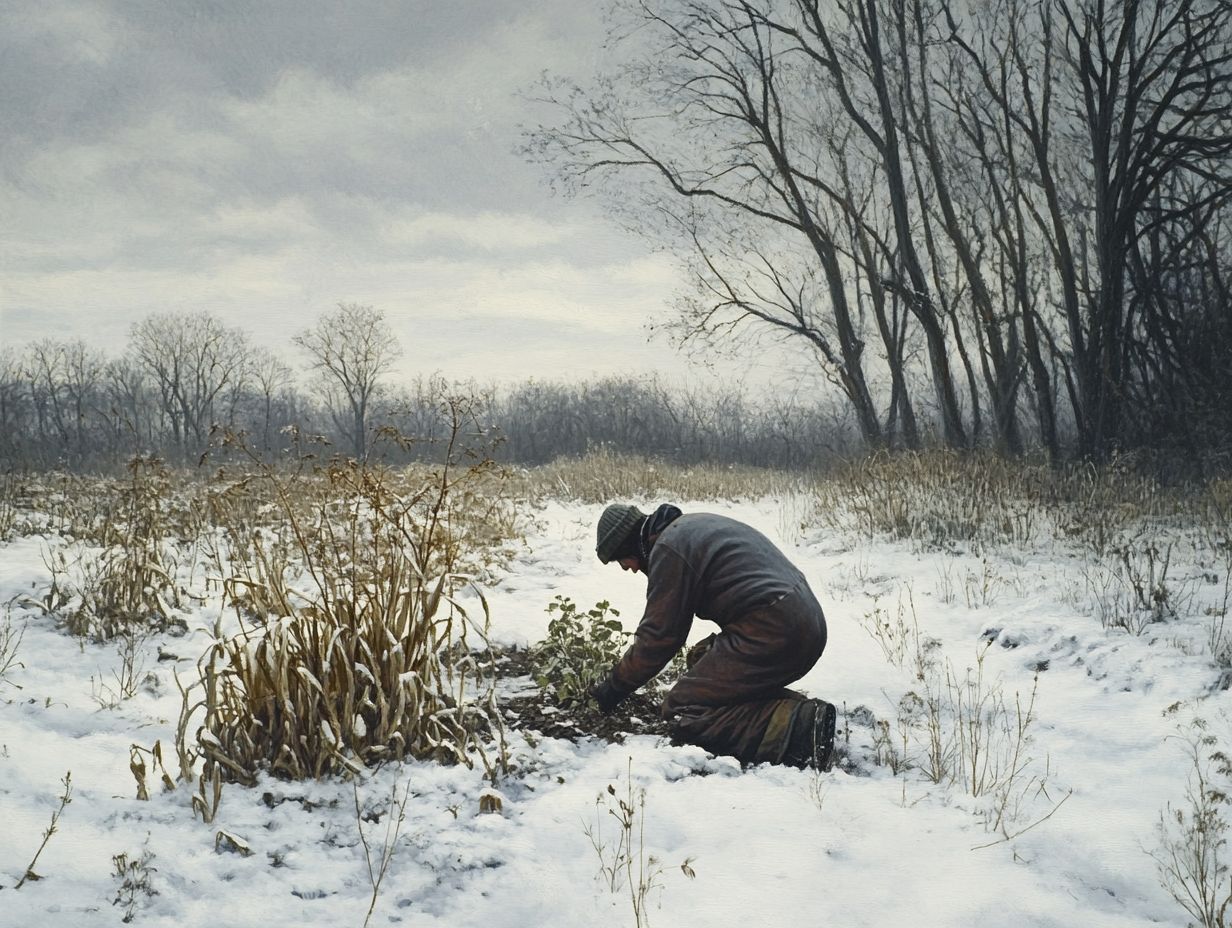
Frost and freezing temperatures can damage your garden if you re in a cold climate. It s crucial to take protective measures to shield your crops.
Choosing frost-resistant varieties of hardy vegetables and employing techniques like row covers and cold frames can effectively reduce risks posed by harsh conditions. These strategies are vital for keeping your plants healthy and maximizing your yield during the brief growing season.
Opt for robust varieties such as kale and Brussels sprouts, which naturally endure lower temperatures, boosting your chances of a successful harvest. Adding mulch provides extra insulation and helps retain moisture.
Timing your planting wisely is key. Avoid vulnerable stages during unexpected frosts to ensure your hard work doesn t go to waste. With careful planning and these proactive measures, you can cultivate a thriving garden, even in winter s chill.
Heavy Snow and Ice
Heavy snow and ice can pose challenges for you as a cold-climate gardener, leading to damage to your plants and complicating gardening activities. Learn how to start a cold-climate garden and understand effective techniques to navigate these obstacles and maintain healthy crops during winter.
Harsh winter conditions can hinder essential tasks like watering and fertilizing. Falling temperatures can lead to frost heave, when the soil expands and contracts, and root damage, which harms your plants. Implement various protective methods to combat these issues.
- Mulching with organic materials can help insulate your soil.
- Constructing windbreaks shields your vulnerable crops from icy blasts.
- Using cold frames or greenhouses extends your growing season, providing much-needed shelter and warmth.
This shows that resilience in gardening isn t just about perseverance; it s about employing strategic approaches to safeguard your cherished plants.
Strategies for Dealing with Cold-Climate Challenges
To thrive in cold climates, adopt effective strategies that address the unique challenges your environment presents. By selecting cold-climate resistant plants and implementing protective measures against frost and freezing, you can significantly enhance your chances of a successful harvest. Understanding the top 5 challenges in winter gardening will further prepare you for even the harshest conditions.
Choosing Cold-Climate Resistant Plants
Choosing plants that resist cold climates is essential for gardening success. Focus on hardy vegetables and resilient perennials to ensure a reliable yield.
Discovering which plants thrive can turn your garden into a vibrant oasis! For instance, vegetables like kale, brussels sprouts, and certain types of carrots are known for their robust nature, thriving even when frost arrives.
Perennials such as sedum and lavender not only withstand the chill but often bloom beautifully during cooler months. This strategic selection extends your growing season and enhances your garden’s ecosystem, attracting beneficial pollinators and enriching the soil.
With this thoughtful approach, you can revel in vibrant landscapes and enjoy productive harvests, even as the temperatures dip.
Protecting Plants from Frost and Freezing
Protecting your plants from frost and freezing temperatures is crucial for their health and ensuring a plentiful harvest. Strategies like using cold frames and row covers can create a microclimate that shields your sensitive plants from temperature extremes.
Cold frames act like mini greenhouses, allowing sunlight to warm the air inside while guarding against biting winds and frost. Positioning these structures in a sunny spot helps maximize heat retention.
Row covers provide an additional layer of insulation by trapping heat and shielding your plants from frost, especially those delicate seedlings. Utilizing both tools can significantly enhance the survival rates of your plants during unexpected cold snaps.
Don’t forget about employing mulch around your plants; it helps retain soil heat, further fortifying their resilience against the chill. Together, these measures form a vital defense system to maintain your plants’ vitality throughout the colder months.
Extending the Growing Season
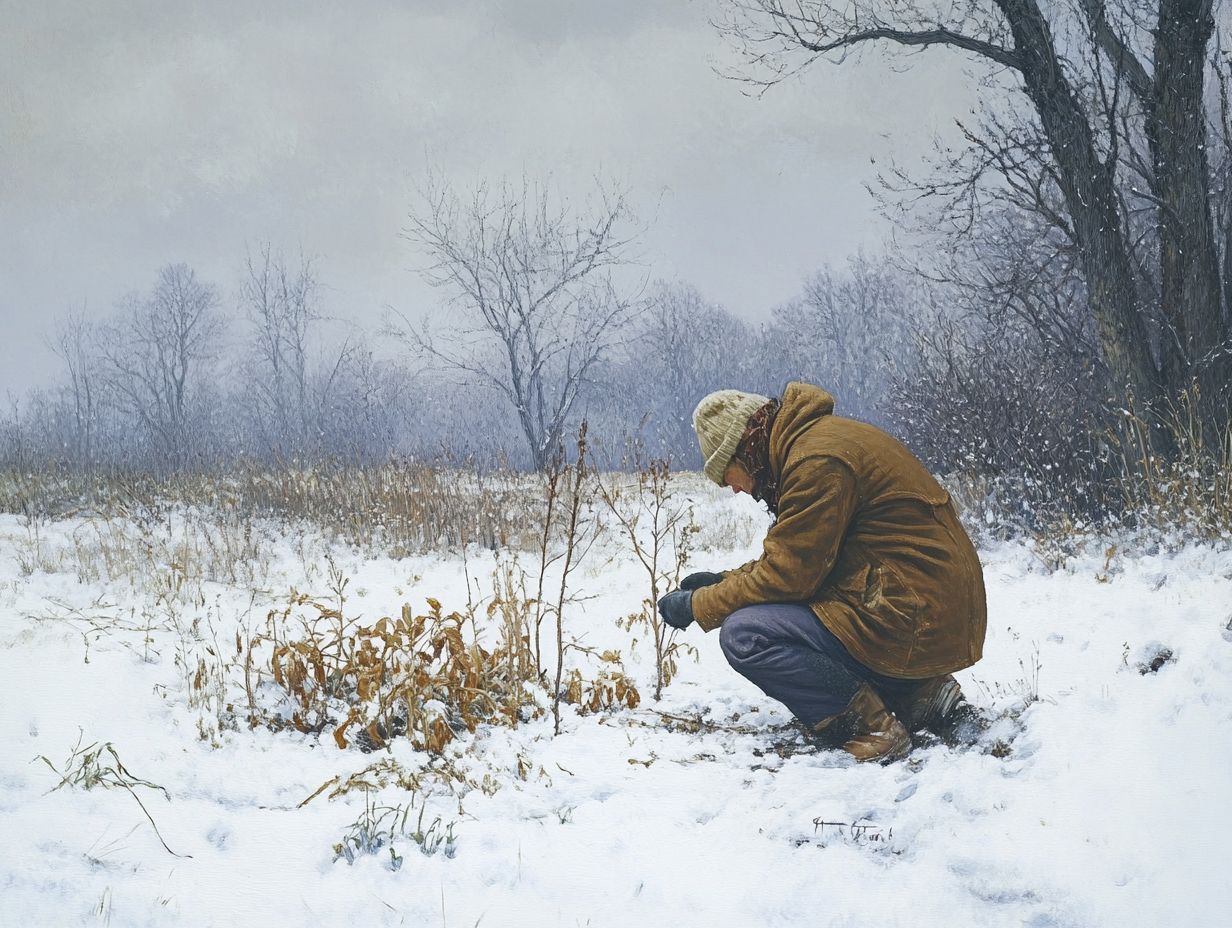
Extending the growing season is essential for you as a cold-climate gardener, enabling you to maximize your harvest despite environmental challenges. By employing techniques such as grow lights and hoop houses, you create favorable conditions that promote plant growth during the colder months.
Utilizing grow lights allows you to simulate sunlight, providing the essential light plants need to make food. With proper positioning of these lights, you can create a controlled environment that significantly enhances growth rates.
Building hoop houses offers a practical solution for shielding your plants from harsh weather. These structures trap heat while allowing sunlight to filter through, acting as mini-greenhouses that can be easily erected. They can extend your growing season by several weeks or even months.
Together, these innovative methods not only improve your yield but also support your quest for sustainable food production, even in the most challenging climates.
Tips for Successful Cold-Climate Gardening
Successful cold-climate gardening relies on several essential practices that enable your plants to flourish despite the challenging conditions, including understanding winter gardening challenges and how to overcome them.
Focus on proper soil preparation, employ effective watering techniques, and implement strategies to maximize sunlight and heat. These integral components will significantly enhance your gardening experience, leading to a fruitful yield even in the face of adversity.
Start planting these hardy varieties today for a flourishing garden this winter!
Proper Soil Preparation
Proper soil preparation is essential in cold-climate gardening. It sets the stage for robust plant growth and fruitful yields. By incorporating organic matter and employing effective composting techniques, you’ll see amazing improvements in soil quality, creating an optimal environment for your plants to thrive.
In areas where winters can be particularly harsh and temperatures plunge, understanding soil health becomes paramount. Improving your soil with organic materials like well-rotted manure or leaf mold not only enriches the nutrient content but also enhances moisture retention, a critical factor given the fluctuations in water availability.
Composting helps create a sustainable gardening approach, infusing the soil with vital microorganisms that decompose organic matter and foster a healthier ecosystem. By focusing on building resilient soil structures, you can ensure your plants are well-equipped to face the challenges posed by cold weather.
Effective Watering and Irrigation
Effective watering and irrigation are vital elements of cold-climate gardening, impacting your plant health and yield. Utilizing methods like drip irrigation optimizes water usage and avoids the pitfalls of overwatering or freezing.
In colder regions where temperatures can swing wildly, having well-thought-out irrigation practices is even more essential. Techniques such as drip irrigation deliver water right to the roots, minimizing evaporation and ensuring moisture reaches those critical areas. This approach significantly lessens the risk of waterlogged soil, which can lead to root rot during your brief growing seasons.
Consider other strategies, such as mulching and using anti-frost covers, to boost water retention and shield your plants from harsh conditions. By adopting these practices, you not only enhance productivity but also promote the overall health of your garden. Start implementing these strategies to help your plants flourish despite the challenges of a cold climate!
Maximizing Sunlight and Heat
Maximizing sunlight and heat is crucial for success in cold-climate gardening. These elements tend to play hard to get during the winter months. By leveraging microclimates and positioning your plants intentionally, you can significantly enhance their exposure to sunlight and cultivate a warmer growing environment.
Start by pinpointing sheltered spots that bask in adequate sunlight while being shielded from biting winds. For example, placing heat-absorbing dark stones or bricks near your plants can soak up warmth during the day and release it at night, creating a cozy little microenvironment for them.
Don t underestimate the power of wall reflections; they amplify light exposure, particularly in southern-facing gardens where sunlight is more plentiful. It s also smart to group together plants that thrive in harmony, as they generate collective warmth and make the most of the space. Ensure your garden continues to flourish, even in the chill of winter!
Some common challenges include shorter growing seasons, frost damage to plants, and freezing temperatures that can harm plants’ root systems. To overcome these issues, it’s helpful to learn how to plan your cold-climate garden layout.Frequently Asked Questions

What are some common challenges when gardening in a cold-climate?
How can I identify if my garden is in a cold-climate region?
If you experience long, cold winters with temperatures below freezing and shorter growing seasons, your garden may face the top challenges of winter gardening in a cold-climate region.
What types of plants are best suited for cold-climate gardening?
Plants that are hardy, able to withstand freezing temperatures, and have shorter growing cycles are best suited for cold-climate gardening. Examples include root vegetables, leafy greens, and certain types of berries.
What are some signs of frost damage to plants?
Signs of frost damage include wilted or blackened leaves, damaged buds or flowers, and slower growth or yellowing of plant foliage.
How can I protect my garden from cold-climate challenges?
Ways to protect your garden include using mulch to insulate soil, covering plants with frost blankets or cloths, and choosing cold-hardy plant varieties.
What are some resources to help me identify and overcome cold-climate gardening challenges?
Local gardening clubs and online forums are great places to start. They offer practical advice from fellow gardeners who understand the unique challenges of cold-climate gardening.
Don t forget to check out gardening blogs and specialized books. These resources provide valuable tips for growing plants successfully in your area.

